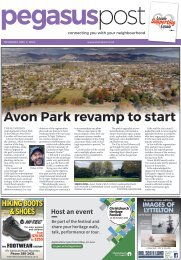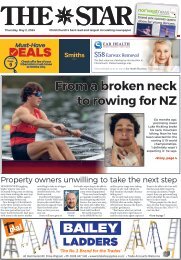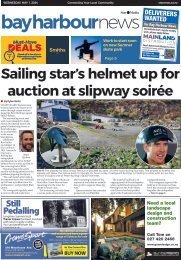Bay Harbour: March 30, 2022
Create successful ePaper yourself
Turn your PDF publications into a flip-book with our unique Google optimized e-Paper software.
EVEN THE most modest<br />
looking of artefacts from the Te<br />
Ūaka The Lyttelton Museum<br />
collection can convey important<br />
stories. This piece of baleen is<br />
both a symbol of a significant<br />
early industry in Aotearoa and of<br />
shifting attitudes towards the use<br />
of natural resources.<br />
Baleen is made of keratin, the<br />
same material that human skin,<br />
hair and fingernails are made<br />
of. Whales which use a baleen<br />
filtering methodology to feed<br />
include the blue, bowhead, right,<br />
humpback, minke and grey<br />
whales.<br />
The baleen is attached to plates<br />
in their upper jaw creating a<br />
sieve-like mechanism. They<br />
take in large quantities of water<br />
through their open mouths then<br />
force the water out with their<br />
tongues, leaving krill, small fish<br />
and even birds trapped behind<br />
the fringe of baleen to then<br />
be swallowed. Early whalers<br />
referred to baleen as whalebone<br />
– a misnomer that became<br />
widespread.<br />
Baleen is strong and quite<br />
flexible and, in the era before<br />
plastics, it was used in many<br />
domestic items, including<br />
umbrella frames, corset stays,<br />
crinoline petticoats, collar<br />
stiffeners, back scratchers, buggy<br />
whips, baskets, chimney brooms<br />
and to press paper.<br />
From the 18<strong>30</strong>s, the first<br />
significant contact between<br />
Maori and Europeans in<br />
Whakaraupō / Lyttelton<br />
<strong>Harbour</strong> was with American,<br />
French, English and Australian<br />
whalers who plied the waters<br />
off Banks Peninsula to hunt the<br />
many whales which travelled the<br />
coastline from colder to warmer<br />
waters to feed and breed.<br />
As at other early settlements<br />
Latest Canterbury news at starnews.co.nz<br />
throughout Aotearoa, mana<br />
whenua traded water, firewood,<br />
pork and potatoes for blankets,<br />
biscuits, firearms and alcohol<br />
and there was intermarriage<br />
between European whalers and<br />
local women.<br />
Numbers of Maori men were<br />
engaged either at shore whaling<br />
stations or onboard ships.<br />
In 1836, a whaling station<br />
was established at the head<br />
of the harbour at Waitata /<br />
Little Port Cooper by Captain<br />
Hempleman of the brig “Bee”.<br />
In spite of not having a jetty, it<br />
was used by ships for respite or<br />
to haul out and process their<br />
catch; rendering down the<br />
blubber into barrels of whale<br />
oil and extracting the valuable<br />
whalebone.<br />
Wednesday <strong>March</strong> <strong>30</strong> <strong>2022</strong> <strong>Bay</strong> <strong>Harbour</strong> News<br />
NEWS 19<br />
Treasures from the past: Whale of a resource<br />
STRONG AND FLEXIBLE: A piece<br />
of baleen from a small whale (date<br />
unknown).<br />
PHOTO: TE ŪAKA THE LYTTELTON<br />
MUSEUM REF 1135.1<br />
WWW.TEUAKA.ORG.NZ/ONLINE-<br />
COLLECTION/603572<br />
Several whalers were buried<br />
in this exposed bay with whale<br />
bones used to mark their graves.<br />
Although the bay remains<br />
accessible only by sea or on foot<br />
today, intrepid visitors still occasionally<br />
sight whale bones on the<br />
beach. The heyday for whaling<br />
around the peninsula was relatively<br />
short lived – a period of<br />
about 40 years. Soberingly, this<br />
was due to the fact that whale<br />
numbers had been so decimated<br />
that hunting was no longer a<br />
viable undertaking.<br />
Up to three million whales<br />
were slaughtered worldwide in<br />
the 19th and early 20th centuries<br />
to feed humankind’s insatiable<br />
appetite for oil and other<br />
by-products like baleen.<br />
Whaling in New Zealand<br />
did not completely end until<br />
1965 when Perano station at<br />
Tory Channel closed, having<br />
caught more than 4000 mainly<br />
humpback whales during its 53-<br />
year operation.<br />
The New Zealand Government<br />
was a founding member of<br />
the International Whaling<br />
Commission in 1946. Whales<br />
in New Zealand waters are<br />
now protected by the Marine<br />
Mammals Protection Act 1978.<br />
There is a strong anti-whaling<br />
sentiment in the population, and<br />
some individuals lend a hand<br />
to try to save whales when they<br />
strand.<br />
Want To Burn Fat Fast?<br />
Burn Up To 2.5 x More Calories In Just 14 Minutes a Day!<br />
Why Bowflex Works For You<br />
Save Time - Don’t let “lack of time”<br />
slow you down.<br />
Lose Weight - Burns Up To 2.5x More<br />
Calories.<br />
Bobbi | Bowflex Max Trainer User<br />
I lost 15kg in 10 weeks. That is ridiculous. The fat just<br />
melts right off. I mean, it absolutely changed my life!<br />
Plus<br />
Get Motivated - Fun, low impact<br />
workouts combined with a<br />
personalised fitness program.<br />
Get Healthy with the HIIT technology<br />
*Call for Terms & Conditions<br />
Free<br />
$950.00 Gift *<br />
CALL NOW! 0800 665 665


















